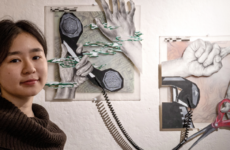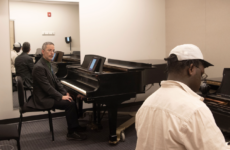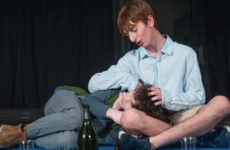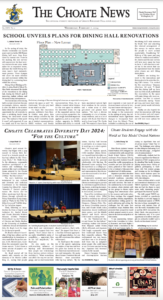
Photo by Toffy Prakittiphoom/The Choate News
The sound of the blaring trumpet, holler of the beating drum, lullaby of the singing cello, chirp of the fluttering flute — in an orchestra, the strings, woodwinds, brass, and percussion sections come together, bringing each of their unique timbres to the cohesive sound of Choate’s Symphony Orchestra. I sat down with members of the string, brass, and woodwind sections to discuss their relationship with music and their preparation for the Instrumental Ensembles Concert, which took place on Sunday, February 20 in Colony Hall.
Grace Liu ’23 has been playing violin for five years. In the ensemble, she switches between the first and second violin sections depending on the piece that is being played. This rotating seating system that Mr. Gene Wie, the Instrumental Ensembles Director, has implemented gives everyone a chance to experience playing in different sections and understand how different parts blend together. Liu explained that the second violins have “the melody very rarely. Playing a supportive part usually involves techniques that aren’t seen in solo playing to create a specific texture so the melody part can be heard.”
Liu also stressed the importance of unity in orchestra. She described that entire sections must play the correct rhythm together to achieve the composer’s intended sound. Even though the melodic accompaniment, such as the second violin section’s part, may be boring to some, without precise accompaniment, a harmonious sound is impossible. Still, she personally prefers sitting in the first violin section and playing the melody. She said, “I like playing the melody more than support, because it always serves as a better vehicle for me to work on my tone and musical interpretation.”
Kenny Tang ’22 has been playing trumpet for eight years. He said the trumpets seldom play the melody, but when they do, they are “impactful moments in the pieces.” Trumpets are one of the loudest instruments in the brass section and can pierce through the orchestra with ease, so they usually receive the melody at grand and powerful parts of a piece. Tang said, “I enjoy playing the melody because it allows the bright tone of our instrument to shine in the orchestra. I also enjoy the energy and power of the ‘Firebird Suite’ by Stravinsky and the elegance of Sibelius’s ‘Karelia Overture’.” His favorite part of orchestra is studying famous masterpieces and working on music with fellow trumpet players.
Gavin Boudreau ’24 has studied clarinet for eight years, and in the Symphony Orchestra, he plays the B flat and A clarinets. He also played oboe in the Symphony last year, which he began learning about six years ago. Boudreau loves playing the melody in pieces: “The most memorable times are the ones spent leading the orchestra and establishing the musical theme. The melody helps drive the music forward and lets the beauty of the instruments playing it shine,” he said.
Boudreau described the repertoire for the concert as “special,” because it displayed a wide range of musicians, genres, and composers, from the Finnish Sibelius to the Russian Stravinsky. In concurrence with Liu, Boudreau appreciates how Mr. Wie chooses pieces that are not generic and popular classical music pieces, like those written by Mozart and Beethoven; instead, there are pieces that “present a different style of music and swerve between tempos and time signatures” — pieces that are not as well known but just as beautiful as the classics.
As engaging and stimulating as it is, participating in the Symphony Orchestra can be challenging. A common dissatisfaction is the quality of an individual’s practice times, or rather, the lack thereof.
Articulating her frustration, Liu said, “It’s difficult to find time at Choate to sit down and work on improving technique.” Therefore, there often seems to be a disparity in the quality of music per section, depending on how difficult the music is for different instruments. Boudreau said, “Though I absolutely adore the people who play in the ensemble…many musicians don’t put in the time and effort needed for us to not just be a good orchestra, but an exceptional one. Covid-19 has presented a lot of challenges and being able to adapt to the ever-changing circumstances has been tough. Our ‘sonic identity,’ as Mr. Wie would describe, has been impacted.”
Though the musicians have different relations with their music, and varying abilities and practice times, they come together three times a week and make the music work. They look forward to seeing what they can accomplish in the last term of the 2021-2022 academic year.




